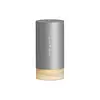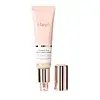What's inside
What's inside
 Key Ingredients
Key Ingredients

 Benefits
Benefits

 Concerns
Concerns

 Ingredients Side-by-side
Ingredients Side-by-side

Water
Skin ConditioningCaprylyl Methicone
Skin ConditioningPhenyl Trimethicone
Skin ConditioningCI 77891
Cosmetic ColorantButylene Glycol
HumectantIsododecane
EmollientTrimethylsiloxysilicate
EmollientLauryl PEG-8 Dimethicone
Propylene Glycol
HumectantSynthetic Fluorphlogopite
CI 77492
Cosmetic ColorantCyclopentasiloxane
EmollientGlycerin
HumectantDisteardimonium Hectorite
StabilisingLauryl PEG-9 Polydimethylsiloxyethyl Dimethicone
Skin ConditioningTriethoxycaprylylsilane
Magnesium Sulfate
Phenoxyethanol
PreservativeCI 77491
Cosmetic ColorantButyrospermum Parkii Butter
Skin ConditioningPolyglyceryl-10 Oleate
Skin ConditioningSqualane
EmollientAlumina
AbrasiveCI 77499
Cosmetic ColorantPolymethylsilsesquioxane
Dimethicone/Vinyl Dimethicone Crosspolymer
Skin ConditioningTocopheryl Acetate
AntioxidantPEG-8
HumectantPanthenol
Skin ConditioningIsostearyl Alcohol
EmollientEthylhexylglycerin
Skin ConditioningSalicylic Acid
MaskingDisodium EDTA
Hydrogenated Lecithin
EmulsifyingCentella Asiatica Extract
CleansingIsostearamidopropyl Ethyldimonium Ethosulfate
Sodium Hydroxide
BufferingSodium Hyaluronate
HumectantCeramide NP
Skin ConditioningCarthamus Tinctorius Seed Oil
MaskingOlea Europaea Fruit Oil
MaskingWhey Protein
Skin ConditioningWater, Caprylyl Methicone, Phenyl Trimethicone, CI 77891, Butylene Glycol, Isododecane, Trimethylsiloxysilicate, Lauryl PEG-8 Dimethicone, Propylene Glycol, Synthetic Fluorphlogopite, CI 77492, Cyclopentasiloxane, Glycerin, Disteardimonium Hectorite, Lauryl PEG-9 Polydimethylsiloxyethyl Dimethicone, Triethoxycaprylylsilane, Magnesium Sulfate, Phenoxyethanol, CI 77491, Butyrospermum Parkii Butter, Polyglyceryl-10 Oleate, Squalane, Alumina, CI 77499, Polymethylsilsesquioxane, Dimethicone/Vinyl Dimethicone Crosspolymer, Tocopheryl Acetate, PEG-8, Panthenol, Isostearyl Alcohol, Ethylhexylglycerin, Salicylic Acid, Disodium EDTA, Hydrogenated Lecithin, Centella Asiatica Extract, Isostearamidopropyl Ethyldimonium Ethosulfate, Sodium Hydroxide, Sodium Hyaluronate, Ceramide NP, Carthamus Tinctorius Seed Oil, Olea Europaea Fruit Oil, Whey Protein
Water
Skin ConditioningCyclopentasiloxane
EmollientTitanium Dioxide
Cosmetic ColorantTalc
AbrasiveZinc Oxide
Cosmetic ColorantButylene Glycol
HumectantEthylhexyl Methoxycinnamate
UV AbsorberCetyl PEG/PPG-10/1 Dimethicone
EmulsifyingNiacinamide
SmoothingCetyl Ethylhexanoate
EmollientEthylhexyl Salicylate
UV AbsorberPentylene Glycol
Skin ConditioningPhenyl Trimethicone
Skin ConditioningPEG-10 Dimethicone
Skin ConditioningAluminum Hydroxide
EmollientMagnesium Sulfate
Stearic Acid
CleansingPhenoxyethanol
PreservativeSilica
AbrasiveDimethicone/Vinyl Dimethicone Crosspolymer
Skin ConditioningTriethoxycaprylylsilane
Trimethylsiloxysilicate
EmollientDimethicone
EmollientEthylhexylglycerin
Skin ConditioningAllantoin
Skin ConditioningDisteardimonium Hectorite
StabilisingDisodium EDTA
BHT
AntioxidantSqualane
EmollientPentaerythrityl Tetra-Di-T-Butyl Hydroxyhydrocinnamate
AntioxidantSodium Hyaluronate
HumectantPanthenol
Skin ConditioningAlpha-Glucan Oligosaccharide
CleansingBetaine
HumectantPolymnia Sonchifolia Root Juice
Skin ConditioningMaltodextrin
AbsorbentLeuconostoc/Radish Root Ferment Filtrate
AntimicrobialLactobacillus/Soybean Ferment Extract
Skin ConditioningLactobacillus Ferment
Skin ConditioningLactobacillus/Acerola Cherry Ferment
Skin ProtectingLactococcus Ferment
Skin ConditioningBifida Ferment Filtrate
Skin ConditioningLactococcus Ferment Lysate
Skin ConditioningLactobacillus/Punica Granatum Fruit Ferment Extract
Skin ConditioningLactobacillus Ferment Lysate
Skin Conditioning1,2-Hexanediol
Skin ConditioningLactobacillus
Skin ConditioningCaffeine
Skin ConditioningWater, Cyclopentasiloxane, Titanium Dioxide, Talc, Zinc Oxide, Butylene Glycol, Ethylhexyl Methoxycinnamate, Cetyl PEG/PPG-10/1 Dimethicone, Niacinamide, Cetyl Ethylhexanoate, Ethylhexyl Salicylate, Pentylene Glycol, Phenyl Trimethicone, PEG-10 Dimethicone, Aluminum Hydroxide, Magnesium Sulfate, Stearic Acid, Phenoxyethanol, Silica, Dimethicone/Vinyl Dimethicone Crosspolymer, Triethoxycaprylylsilane, Trimethylsiloxysilicate, Dimethicone, Ethylhexylglycerin, Allantoin, Disteardimonium Hectorite, Disodium EDTA, BHT, Squalane, Pentaerythrityl Tetra-Di-T-Butyl Hydroxyhydrocinnamate, Sodium Hyaluronate, Panthenol, Alpha-Glucan Oligosaccharide, Betaine, Polymnia Sonchifolia Root Juice, Maltodextrin, Leuconostoc/Radish Root Ferment Filtrate, Lactobacillus/Soybean Ferment Extract, Lactobacillus Ferment, Lactobacillus/Acerola Cherry Ferment, Lactococcus Ferment, Bifida Ferment Filtrate, Lactococcus Ferment Lysate, Lactobacillus/Punica Granatum Fruit Ferment Extract, Lactobacillus Ferment Lysate, 1,2-Hexanediol, Lactobacillus, Caffeine
Ingredients Explained
These ingredients are found in both products.
Ingredients higher up in an ingredient list are typically present in a larger amount.
Butylene Glycol (or BG) is used within cosmetic products for a few different reasons:
Overall, Butylene Glycol is a safe and well-rounded ingredient that works well with other ingredients.
Though this ingredient works well with most skin types, some people with sensitive skin may experience a reaction such as allergic rashes, closed comedones, or itchiness.
Learn more about Butylene GlycolCyclopentasiloxane, or D5, is a silicone used to improve texture of products and trap moisture.
D5 is considered lightweight and volatile. Volatile means it evaporates quickly after application. Once evaporated, D5 leaves a thin barrier that helps keep skin hydrated.
It is also an emollient. Emollients help soften the skin and prevent water loss. Silicones create a silky texture in products. D5 helps other ingredients become more spreadable.
Studies show D5 is safe to use in skincare products. We recommend speaking with a skincare professional if you have concerns.
Learn more about CyclopentasiloxaneThis ingredient is a silicone used to improve the texture of products and absorb oil. It does not get absorbed into the skin.
Like other silicones, Dimethicone/Vinyl Dimethicone Crosspolymer helps condition the skin by creating a barrier. In this sense, it can act as an emollient and trap moisture in.
This ingredient is a type of elastomer.
Learn more about Dimethicone/Vinyl Dimethicone CrosspolymerDisodium EDTA plays a role in making products more stable by aiding other preservatives.
It is a chelating agent, meaning it neutralizes metal ions that may be found in a product.
Disodium EDTA is a salt of edetic acid and is found to be safe in cosmetic ingredients.
Learn more about Disodium EDTADisteardimonium Hectorite comes from the clay mineral named hectorite. It is used to add thickness to a product.
It can also help stabilize a product by helping to disperse other ingredients.
Hectorite is a rare, white clay mineral.
Learn more about Disteardimonium HectoriteEthylhexylglycerin (we can't pronounce this either) is commonly used as a preservative and skin softener. It is derived from glyceryl.
You might see Ethylhexylglycerin often paired with other preservatives such as phenoxyethanol. Ethylhexylglycerin has been found to increase the effectiveness of these other preservatives.
Magnesium Sulfate is a salt. More specifically, it is an epsom salt, or the bath salt used to help relieve muscle aches.
Despite having ‘sulfate’ in the name, it isn’t a surfactant or cleansing agent like sodium lauryl sulfate. Unlike those sulfates, magnesium sulfate doesn’t have the same cleansing or foaming properties (it's simply a type of salt).
In cosmetics, Magnesium Sulfate is used to thicken a product or help dilute other solids. It is a non-reactive and non-irritating ingredient.
One study shows magnesium deficiency may lead to inflammation of the skin. Applying magnesium topically may help reduce inflammation.
You can find this ingredient in sea water or mineral deposits.
Learn more about Magnesium SulfatePanthenol is a common ingredient that helps hydrate and soothe the skin. It is found naturally in our skin and hair.
There are two forms of panthenol: D and L.
D-panthenol is also known as dexpanthenol. Most cosmetics use dexpanthenol or a mixture of D and L-panthenol.
Panthenol is famous due to its ability to go deeper into the skin's layers. Using this ingredient has numerous pros (and no cons):
Like hyaluronic acid, panthenol is a humectant. Humectants are able to bind and hold large amounts of water to keep skin hydrated.
This ingredient works well for wound healing. It works by increasing tissue in the wound and helps close open wounds.
Once oxidized, panthenol converts to pantothenic acid. Panthothenic acid is found in all living cells.
This ingredient is also referred to as pro-vitamin B5.
Learn more about PanthenolPhenoxyethanol is a preservative that has germicide, antimicrobial, and aromatic properties. Studies show that phenoxyethanol can prevent microbial growth. By itself, it has a scent that is similar to that of a rose.
It's often used in formulations along with Caprylyl Glycol to preserve the shelf life of products.
Phenyl Trimethicone is a silicon-based polymer. It is derived from silica.
Phenyl Trimethicone is used as an emollient and prevents products from foaming.
As an emollient, it helps trap moisture in the skin. It is considered an occlusive.
Learn more about Phenyl TrimethiconeSodium Hyaluronate is hyaluronic acid's salt form. It is commonly derived from the sodium salt of hyaluronic acid.
Like hyaluronic acid, it is great at holding water and acts as a humectant. This makes it a great skin hydrating ingredient.
Sodium Hyaluronate is naturally occurring in our bodies and is mostly found in eye fluid and joints.
These are some other common types of Hyaluronic Acid:
Learn more about Sodium HyaluronateSqualane is an emollient that helps the skin hold onto moisture. It's an oily liquid that occurs naturally in certain types of fish and plant oils.
Because squalane boosts hydration in the skin, it also comes with plenty of benefits: it is an antioxidant and can help fight free radicals and skin damage. Squalane is also found to have a detoxifying effect when applied.
Squalane comes from squalene, which occurs naturally within the sebum of our skin. It is one of the oils our skin produces to keep itself hydrated. Squalane is the hydrogenated version of squalene and has a longer shelf life.
Research shows that squalane is non-irritating (even at 100% concentration).
In general, it's a fantastic ingredient. It does a great job at hydrating the skin, and it's suitable for those with sensitive skin.
The source of squalane may impact malassezia / fungal acne. This is because olive oil derived squalane can contain impurities such as fatty acids and plant waxes. Sugarcane derived squalane is recommended for anyone with malassezia concerns.
Is squalane vegan?
This depends on the source. Squalane can be derived from both plants and animals. Most squalane used in skincare comes from plants.
Please note: the source of squalane is only known if disclosed by the brand. We recommend reaching out to the brand if you have any questions about their squalane.
Read more about squalene with an "e".
Is squalane an oil?
Squalane is often called an oil, but it’s technically not; it’s a hydrocarbon, meaning it’s only made of carbon and hydrogen, unlike true oils which are triglycerides made of fatty acids and glycerol.
The term “oil-free” isn’t regulated, so companies can define it however they want. Some exclude all oils, while others just avoid mineral oil or comedogenic oils.
While some people avoid oils thinking they cause breakouts, the right kind of oil (or oil-like ingredient like squalane) can actually help balance and hydrate your skin. It’s worth testing out simple oils or squalane to see what works best for your skin.
Learn more about SqualaneTriethoxycaprylylsilane is a silicone used to bind and stabilize ingredients.
As an emulsifier, it helps prevent ingredients from separating. This can help elongate the shelf life of products.
Triethoxycaprylylsilane is often used to coat mineral sunscreens ingredients to help give a better feel. It also helps reduce oxidative stress in sunscreens.
Learn more about TriethoxycaprylylsilaneThis silicone is an emollient. Emollients create a thin film on the skin to prevent moisture from escaping.
It is not soluble in water and helps increase water-resistance in products.
According to a manufacturer, it can blend seamlessly with silicone oils, such as Cyclopentasiloxane.
Learn more about TrimethylsiloxysilicateWater. It's the most common cosmetic ingredient of all. You'll usually see it at the top of ingredient lists, meaning that it makes up the largest part of the product.
So why is it so popular? Water most often acts as a solvent - this means that it helps dissolve other ingredients into the formulation.
You'll also recognize water as that liquid we all need to stay alive. If you see this, drink a glass of water. Stay hydrated!
Learn more about Water